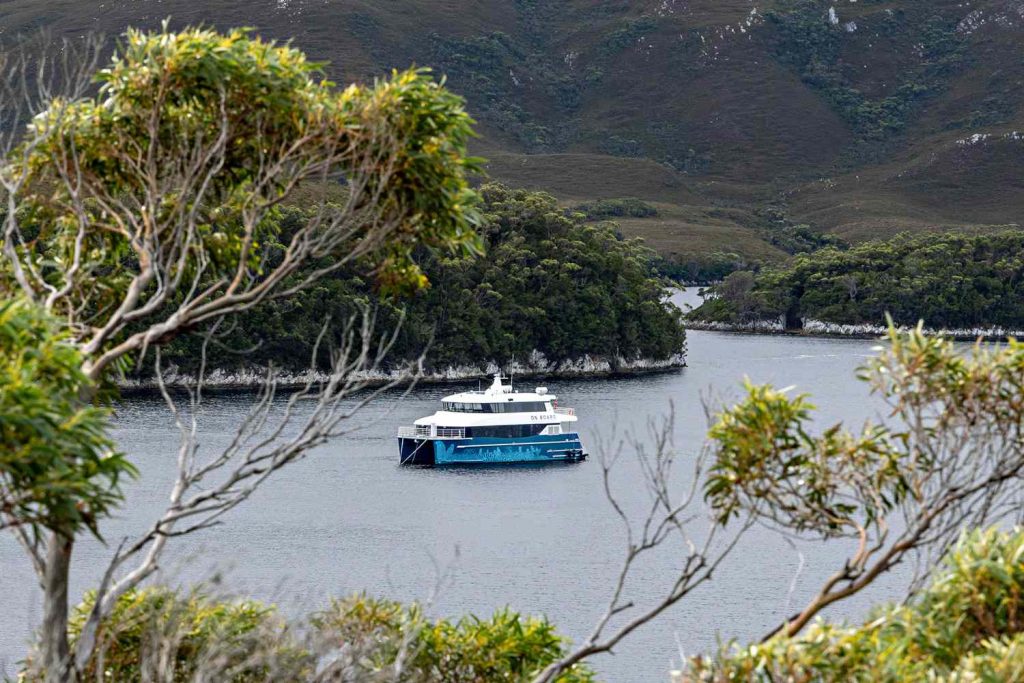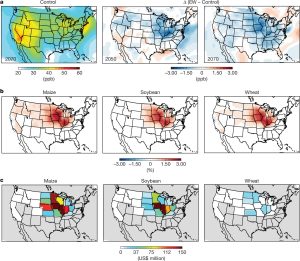:max_bytes(150000):strip_icc():format(jpeg)/TAL-catamaran-inlet-water-ONBOARDTASMANIA0225-b56624846b3649c3a74e4b8873559896.jpg)
Standing atop a mountain, looking out over Port Davey — an inlet of the Southern Ocean in southwestern Tasmania — Pete Marmion told me the quirky way in which he measures bodies of water.
“It goes milliliters, liters, Olympic pools, and then Sydney Harbours,” joked Marmion, a local guide with more than three decades of experience showing visitors around Tasmania. “Port Davey is three times the size of Sydney Harbour.”
Sydney Harbour is 12 miles long and has a total area of 21 square miles; it’s one of the largest natural harbors in the world. From the top of the mountain, watching a torrential rain pour into the water far below, I thought Marmion’s estimate seemed sound.
Port Davey’s dark, tannin-stained waters lie at the feet of ancient quartzite mountains that look as if they’ve been squished, layered, and stretched toward the horizon like taffy. Just a few hours earlier, I had zoomed over those same peaks in a seaplane to Port Davey Marine Reserve, a nearly 69-square-mile parcel of primordial coastline in Southwest National Park. It is part of a sprawling UNESCO Wilderness World Heritage Area that makes up nearly a quarter of the island. There I boarded my floating home for the next seven days, Odalisque III.
Justin Meneguzzi
With no roads, towns, or accommodation other than campsites, the reserve once mainly attracted die-hard campers and boaters accustomed to arduous sailing conditions. But now Odalisque III, a shiny 78-foot catamaran from On Board Tasmanian Expedition Cruises, is offering unrivaled access to this beautiful and rugged corner of Australia’s deepest south, which sits some 1,600 miles north of Antarctica. Sailings run from December to May, during which time the region’s unpredictable weather abates for long enough to allow for comfortable exploration.
After dropping off our bags and being greeted by our bare-bones crew — Marmion, as well as a skipper, a host, and a chef — our group of eight hiked up Mount Beattie, the first of many excursions in store for us that week. “I bring artists here and it’s like watching a dog wag its tail,” Marmion said. A native Tasmanian, he wears many hats: guide for On Board, as well as conservationist and author of Hidden Worlds, a collection of photos and stories from his decades exploring southwestern Tasmania.
Justin Meneguzzi
Marmion is also an irrepressible optimist. Even though we were both soaked to the bone, he predicted the weather was about to break. In a landscape that suffers no fools, “you need to be able to see the bright side,” Marmion told me. Sure enough, the rain stopped, and we began our descent back to the pier as a rainbow appeared above our heads.
Before it started raining again, we ducked inside Claytons Corner, a former home turned public shelter on the jetty that has served as a reprieve from the elements since the 1960s. Our skipper, On Board founder Pieter van der Woude, surprised the group with oysters, sparkling wine, and a roaring fire in the brick hearth. In time, I would look back at this moment, when we were cozy around the flames, and realize that it encapsulated everything about my seven-day journey: untamed landscapes were consistently tempered by sublime beauty, and temporary discomforts were rewarded with luxury.
At the start of each day, we would set off from Odalisque III in aluminum dinghies to explore the area’s creeks, bays, and channels. (Itineraries are shaped by weather conditions, meaning that no two sailings are exactly alike.) One day we’d putter down winding creeks in search of elusive black swans; another we’d lace up for a mountain hike or visit an abandoned tin mine.
Another afternoon we motored the dinghies around the Breaksea Islands, a collection of jagged outcrops and caverns that guard the choppy mouth of the marine reserve. The waves heaved beneath our small boat on their way to batter the cliffs, giving us a small yet thrilling taste of what these seas are capable of.
Justin Meneguzzi
After each adventure, I was grateful for a hot shower in my small but functional cabin. There was also time to unwind before dinner, eaten communally and designed to showcase foods native to Tasmania, like deliciously gamy wallaby roast.
On some nights I picked up a book about the reserve from the small library and enjoyed a history lesson with a mug of spiced hot chocolate. On others, I joined my fellow guests in Odalisque III ’s plush lounge to watch a documentary or play a board game. Either way, I always retired to my cabin by 9 p.m., ready for the gentle rocking of the boat to lull me to sleep. (Each night the catamaran motored to another site within the reserve, so we could wake up in a new location.)
Our luxurious experience was markedly different from that of the handful of people who, despite the incredibly challenging climate southwestern Tasmania is known for, once managed to eke out a living in this region. One morning we cruised to the remote locality of Melaleuca. While the place was inhabited once, it is now primarily abandoned, though frequented by hikers, tour groups, and bird-watchers hoping to catch a glimpse of the endangered orange-bellied parrot. We walked the garden paths where the late legendary outdoorsman and environmentalist Deny King built a home and raised a family while mining tin from beneath the thick peat. King’s daughter Janet Fenton still tends to her father’s beloved patch of wilderness. Walking past vegetable gardens and toolsheds, we felt like we were trespassing — a sense that only intensified when we rudely interrupted a wallaby grazing beside a clothesline.
Justin Meneguzzi
Nearby, we wandered along the edge of Melaleuca Lagoon, exploring an Aboriginal interpretive walk created by the Tasmanian Parks & Wildlife Service and the Tasmanian Aboriginal Land & Sea Council. The short trail passes faithful re-creations of domed huts and paperbark canoes, offering a glimpse of how the Indigenous Needwonnee people lived and cultivated the land. Following British settlement in the early 1800s, aggressive relocation policies removed all Aboriginal people from southwestern Tasmania. The Needwonnee were part of a long chain of humans here, some of whom tried to work the land to different ends — including for whaling, mining, or tourism — but Port Davey has always proved untamable.
And yet, hundreds of species of wildlife, on land and within the waters of the reserve, live on. On Board is striving to protect the national park by supporting programs that eradicate pests and rescue birds of prey, such as the Tasmanian wedge-tailed eagle, which is now endangered because of the disturbance and loss of nesting sites. Marmion himself has spent 35 years as a volunteer working to restore orange-bellied parrot populations in Port Davey; it is estimated that there are fewer than 100 of these birds in the area today.
On one of our final days, Marmion was telling me stories of past adventures around Tasmania over lagers in the lounge on the upper deck. We watched as a new tempest started to make its way down the mountains, an occurrence that took place several times throughout the journey. True to form, he told me to “just give it a minute.” A few moments later, as if on cue, the clouds broke.
Four- and six-night expeditions in Port Davey with On Board Tasmanian Expedition Cruises.
A version of this story first appeared in the February 2025 issue of Travel + Leisure under the headline “Deep South.”








